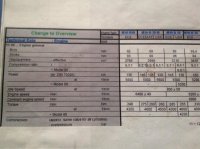Hi Folks,
Sorry if this is redundant, but I did search. I'm doing some research on '71 2800CS that I hope to buy. It is in fact a euro model. I read the FAQ as seen below. Other than the interior differences, is there anything different about the 2.8 engine? It looks like the compression didn't change until the intro of the 3.0. Are there emissions differences on the 2800 euros? Anything else that is notable.
The car in question has standard roundels and the rear trim plate looks like aluminum, not plated brass. Also, the car has reflectors, which must have been applied when federalized. The car was originally intended for Italy, but was ultimately shipped to Germany. I've noticed other '71 2800's such as Mike's - Stanceworks E9 (gasp) also had reflectors although imported.
Any info would be greatly appreciated.
Sorry if this is redundant, but I did search. I'm doing some research on '71 2800CS that I hope to buy. It is in fact a euro model. I read the FAQ as seen below. Other than the interior differences, is there anything different about the 2.8 engine? It looks like the compression didn't change until the intro of the 3.0. Are there emissions differences on the 2800 euros? Anything else that is notable.
The car in question has standard roundels and the rear trim plate looks like aluminum, not plated brass. Also, the car has reflectors, which must have been applied when federalized. The car was originally intended for Italy, but was ultimately shipped to Germany. I've noticed other '71 2800's such as Mike's - Stanceworks E9 (gasp) also had reflectors although imported.
Any info would be greatly appreciated.
5. What differences are there between US and European E9s?
There are major differences in US and Euro E9s. First, the compression ratio in the US 3.0CS was reduced to 8:1, while the Euro cars were 9:1, giving them more power. The US cars have side marker lights in the front and back, which go next to the main turn signals. The later (>73) US cars have additional smog equipment, such as an EGR system. Starting in 1974 the US versions came with large 5mph aluminum bumpers front and rear. Although these large bumpers are said to take away from the beautiful lines of the coupe, the 5mph crash bumpers work well and have saved a number of coupes over the years. Some owners prefer the later large bumpered cars if they do a lot of driving in the city or traffic. Later US coupes also have a "Fasten Seat Belt" light pod on the dash. The Euro gauges are in Metric, while the US ones are in standard. The heater vent controls are either in German or in the international symbols for Euro cars, while they are in English for the US cars. Euro cars also only had a lap belt, while US cars have stock shoulder belts. This is usually already fixed, as most of the Euro cars have shoulder belts added later on, either as part of the federalization process or the owner added them. The US also had slightly larger front turn signal lenses. A slight difference in Euro models can be seen in Italian coupes, which have a white and amber turn signal lens, rather than the all amber used everywhere else. French cars have yellow headlight lenses and amber reverse lights. All US models have DOT required spacers on top of R/L strut below inner engine compartment sheet metal to raise front end height approximately 1" to meet sealed beam headlight height requirements. Early cars had cloissoine roundels at "C' pillar and chromed brass trim between tailights which was changed to raised painted alum. roundels and anodized alum. during 1972 model run to reduce costs. Early cars had wider stock seats and seat back release mechanism at the hinge, by 1971 a small lever mounted on outside of upper seat edge replaced the old mechanism

